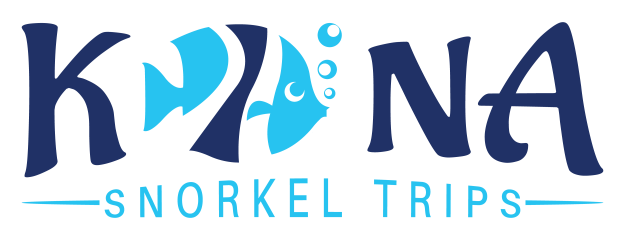Unforgettable Whale Watching Tours in Kona Hawaii | Book Now
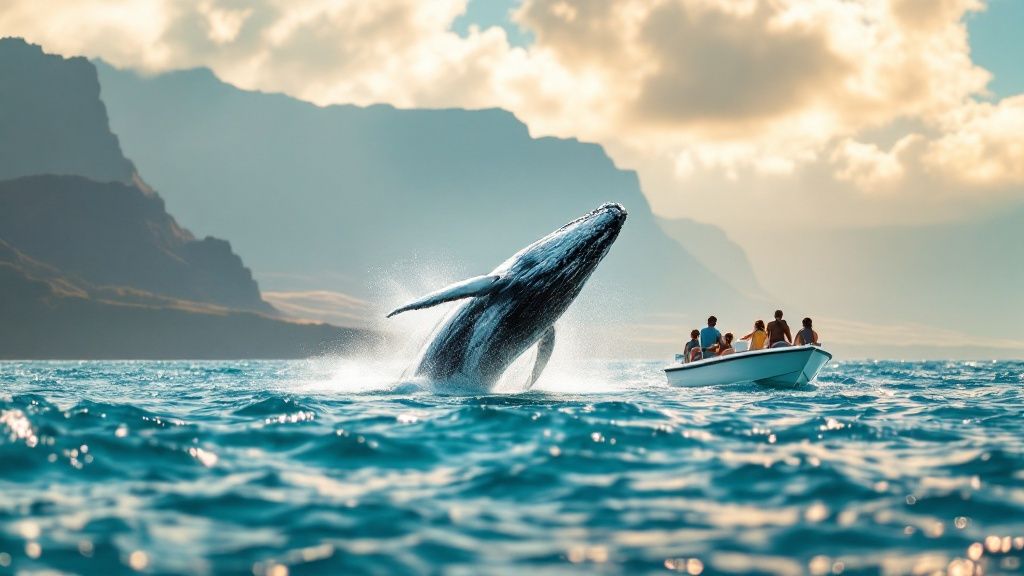
Picture this: the calm, turquoise surface of the Pacific erupts as a forty-ton humpback whale launches its entire body into the air. This is the moment at the heart of whale watching tours in Kona, Hawaii—an experience that brings you face-to-face with some of the most magnificent creatures on Earth. Every year, from December through March, thousands of humpback whales make their way to Kona's warm, sheltered waters, putting on a natural spectacle you'll never forget.
As the top-rated and most reviewed snorkel company in Hawaii, Kona Snorkel Trips is dedicated to providing an unparalleled experience.
Experience Kona's Majestic Humpback Whales
Each winter, the serene Kona coast becomes a bustling nursery and playground for the North Pacific humpback whale population. These gentle giants travel an incredible 3,000 miles from their chilly feeding grounds in Alaska to mate, give birth, and raise their newborn calves in Hawaii's protected seas. It's truly one of nature's most epic journeys.
The sheer scale of this migration is hard to wrap your head around. During the peak season, the ocean is simply alive with activity, cementing Kona's reputation as one of the best places in the world for whale watching. This isn't just a feeling; recent whale counts have confirmed just how critical this area is for the species.
Why Kona is a Whale Watching Hotspot
The Big Island's geography is what makes it so special. The colossal volcanoes, Mauna Loa and Hualalai, stand as natural sentinels, shielding the Kona coast from the powerful trade winds. The result? Exceptionally calm and clear waters, creating perfect conditions for the whales—and for us to see them.
This natural sanctuary provides a safe harbor for mothers and their calves. Here, they can rest and nurse, helping the young ones build strength for the long, demanding swim back north. The concentration of whales is just amazing. A recent survey found that during peak season, nearly 500 humpback whales were spotted from the Big Island's shores in a single day. You can read more about these impressive whale counts to get a sense of the scale.
"Witnessing a mother humpback whale gently guide her newborn calf through the calm Kona waters is a profoundly moving experience. It’s a reminder of the delicate and powerful cycles of nature happening right before your eyes."
At Kona Snorkel Trips, we feel privileged to share this world with you. As Hawaii's top-rated and most-reviewed snorkel and tour company, our entire mission is to provide an intimate, respectful, and educational adventure. Our expert crew and small-group tours guarantee you a front-row seat to the awe-inspiring behaviors of these incredible animals.
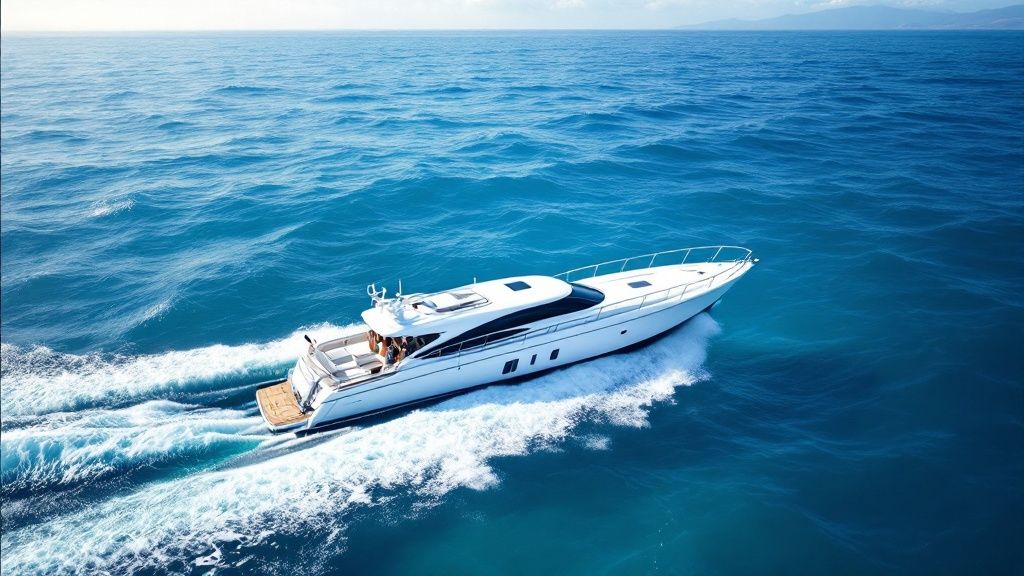
Why Kona Is a Perfect Humpback Whale Sanctuary
Kona's reputation for amazing whale watching tours in Kona, Hawaii, isn't just by chance. It all comes down to the Big Island’s incredible geography. The island itself acts as a natural fortress, creating one of the most protected marine environments you'll find anywhere in the Pacific, which is exactly why humpback whales travel thousands of miles to get here.
Think of Mauna Loa and Hualalai, two of the largest volcanoes on the planet, as giant bodyguards for the coastline. These massive peaks block the strong northeasterly trade winds that whip across most of the other Hawaiian islands.
This creates a huge 'lee' along the Kona coast—a massive stretch of ocean that stays remarkably calm, warm, and clear. It’s like nature built a gigantic, peaceful harbor, offering a safe haven from the rough-and-tumble open seas.
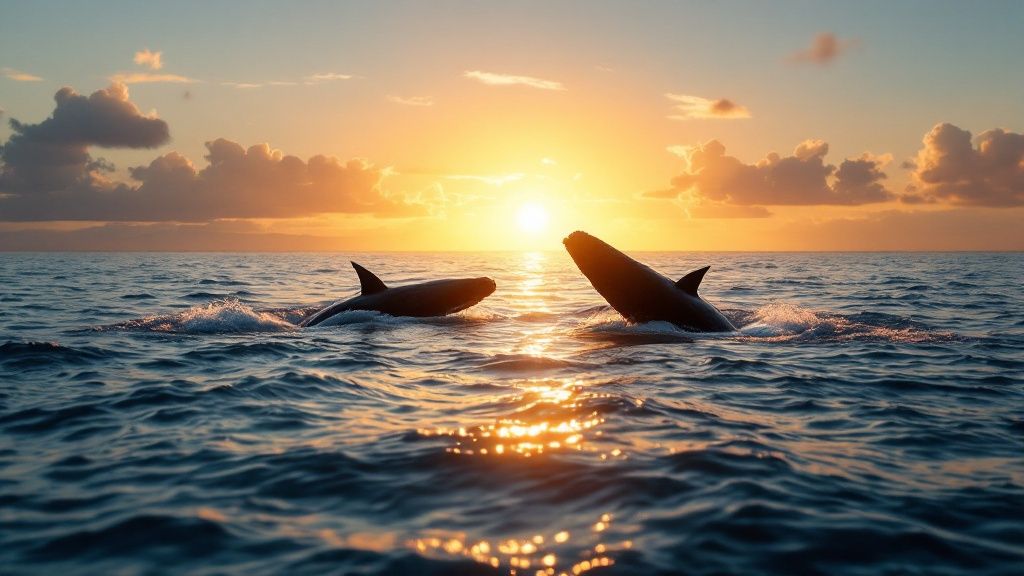
A Natural Nursery for Newborn Whales
This tranquil environment is a game-changer for mother whales and their newborn calves. After making the long, demanding journey from the cold waters of Alaska, pregnant females specifically seek out these gentle seas to give birth. The benefits here are huge:
- Safety from Predators: The clear, relatively shallow waters don’t give predators like large sharks many places to hide, making it a much safer space for a vulnerable calf.
- Energy Conservation: Calves are born without the thick blubber layer that keeps adults warm. The balmy water here, which averages 75-80°F (24-27°C), helps them save critical energy that would otherwise be spent just trying to stay warm.
- Ideal Learning Conditions: Imagine trying to teach a baby to swim in a wave pool—it wouldn't be easy. The calm Kona seas are the perfect classroom for a calf to learn essential skills from its mother, like breathing, swimming, and communicating, without fighting against rough surf.
For humpback whales, the protected waters of Kona aren't just a preference; they're a biological necessity. This unique coastal geography provides the exact conditions needed for the next generation of these magnificent animals to survive and thrive.
The profound calmness of the water is also what makes Kona’s whale watching tours so special for us. Unlike tours in other, windier parts of Hawaii, our boats are far more stable. That means a more comfortable and enjoyable experience for everyone on board.
This stability also opens the door for much closer and more intimate encounters. When the water is like glass, it’s so much easier to spot a distant spout, a spectacular breach, or the subtle, gentle movements of a mother and her calf right beside the boat. It all comes back to the Big Island's massive volcanoes creating the peaceful, warm waters perfect for raising a whale. You can learn more about Kona's ideal whale environment and see for yourself why so many humpbacks make this their winter home. It’s this natural advantage that truly makes Kona an unparalleled sanctuary.
How To Time Your Tour For Peak Whale Season
When it comes to whale watching in Kona, timing is everything. It’s the single biggest factor that separates a good trip from an absolutely unforgettable one. While you can spot whales from December through March, knowing the sweet spots within that window can dramatically increase your chances of seeing the most spectacular action.
The humpbacks start trickling in during the late fall, but the real show doesn’t get going right away. Think of it like a music festival—the gates open early, but the headliners don't take the stage until later. December is when we start seeing them consistently, and by the end of March, they’re heading back to Alaska for the summer. Your mission is to book your tour right in the middle of that four-month concert.
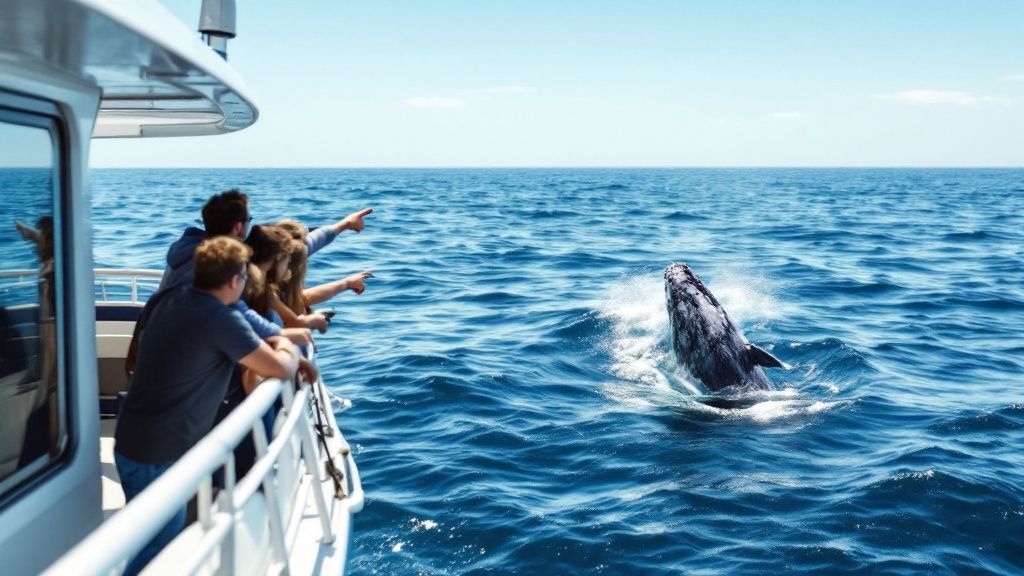
Pinpointing The Peak Months
If you’re after the kind of day where you see breaches, tail slaps, and all-out whale acrobatics, you need to aim for January and February. These two months are, without a doubt, the peak of the season.
During this time, the waters off the Kona coast are buzzing with activity. Thousands of whales are here for the most important events of their lives: breeding, giving birth, and nursing their newborn calves. With so many whales concentrated in one area, you’re naturally going to see more action on the surface.
The Big Island's Kohala Coast, in particular, becomes a veritable whale highway. It’s not uncommon for us to see two or three times more whales here than in other spots around the island. In the heart of the season, observers often report seeing an average of 3 to 6 whales every 15 minutes. It’s an incredible sight.
Morning vs. Afternoon: Which Tour Is Better?
Okay, so you’ve picked your month. Now, should you go in the morning or the afternoon?
While whales are active all day, morning tours often have a clear edge. The Kona coast is legendary for its calm, glassy mornings. As the day wears on, the trade winds tend to pick up, bringing more chop and swell with them.
The calmer the water, the easier it is to spot the telltale signs of a whale—a distant spout, a dorsal fin breaking the surface, or the massive fluke of a tail. The glassy conditions of the morning create a perfect canvas for whale watching.
A morning trip usually means a smoother ride and better visibility, which translates to better, clearer sightings. That said, afternoon tours are still fantastic! You'll still see whales, and the lower angle of the sun can create some beautiful, dramatic lighting for photos. You can discover more about the best times to see whales in our detailed guide to the Big Island whale season.
Ultimately, any tour during the peak months gives you a phenomenal shot at an amazing experience. To help you weigh your options, here’s a quick breakdown of what to expect throughout the season.
Kona Whale Watching Season At-a-Glance
This table summarizes whale watching conditions and activity levels by month and time of day to help you plan the perfect tour.
| Timeframe | Whale Activity Level | Typical Ocean Conditions | Best For |
|---|---|---|---|
| Early Season (Dec) | Moderate | Calm to moderate | Seeing the first arrivals of the season. |
| Peak Season (Jan-Feb) | Very High | Generally calm, especially mornings | Maximizing sightings and seeing active behaviors. |
| Late Season (Mar) | Moderate to High | Can be windier | Witnessing mothers with their growing calves. |
| Morning Tours | High | Calmest, glassy water | The smoothest ride and best visibility for spotting. |
| Afternoon Tours | High | More wind and chop | Good for dramatic lighting and still-active whales. |
No matter when you decide to go, being out on the water during whale season is a powerful experience you won't soon forget.
What to Expect on Your Whale Watching Adventure
The moment you step aboard one of our boats, you can feel it. There’s a buzz of excitement in the air as we pull away from the harbor and start cruising along the beautiful Kona coast. Our guides will start sharing stories and facts about the ocean life here, but everyone’s eyes are glued to the horizon, scanning for that first giveaway—a misty spray shooting into the sky.
Then you hear it, the shout everyone’s been waiting for: “Whale!” The energy on the boat instantly changes. It’s electric. This isn’t just a boat ride anymore; you’ve got a front-row seat to one of nature's greatest shows. This is where the real magic of a Kona, Hawaii whale watching tour begins, and our guides will help you understand every incredible moment.
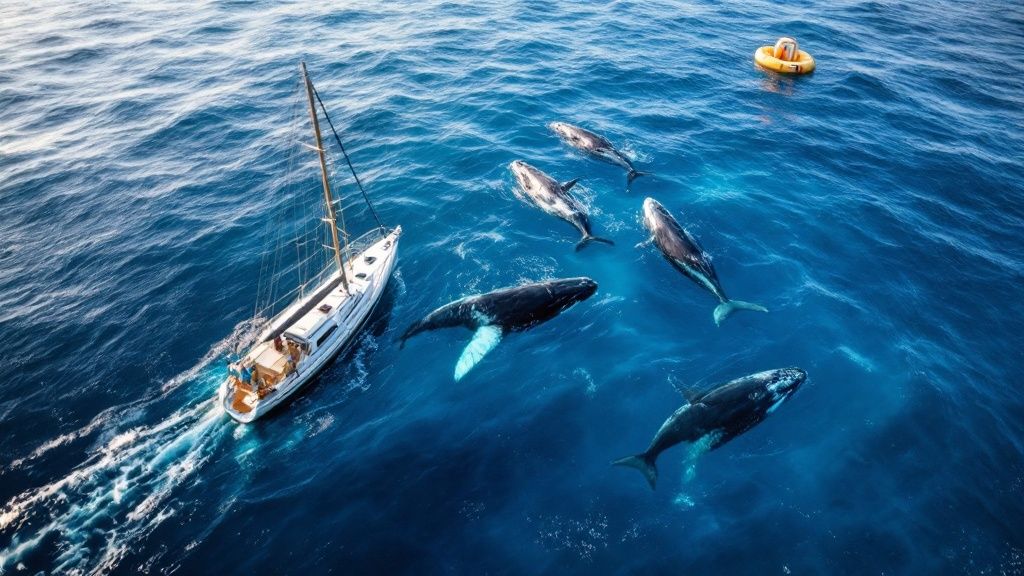
Decoding Whale Behaviors
Watching humpbacks is like listening in on a secret conversation. Every splash and movement has meaning, and knowing what to look for makes the experience that much richer.
- The Breach: This is the ultimate showstopper. Seeing a 40-ton animal launch its entire body out of the water is something you never forget. They crash back down with a spectacular splash, which experts think might be a way to communicate or even just to scratch an itch by knocking off parasites.
- The Tail Slap: You'll often hear this before you see it. A humpback will lift its massive tail fluke out of the water and smack it down with incredible force. That thunderous clap can be heard for miles underwater—it’s a powerful way to send a message.
- The Spy-Hop: This one feels personal. A whale will slowly and gracefully lift its head straight out of the water to get a look around. It's pure curiosity, and when they turn their gaze toward the boat, it feels like they’re just as interested in us as we are in them.
One of the most touching things you can see is a mother whale gently guiding and teaching her new calf. These quiet, tender moments are a powerful reminder of the deep bonds these incredible animals share.
The Kona Snorkel Trips Advantage
We’ve always believed that a smaller boat leads to a bigger, better experience. Our tours are intimate and personal, which lets us get you closer to the action without being disruptive.
Unlike the big, crowded tour boats, our vessels are nimble and quiet. This means we can position ourselves for amazing views without disturbing the whales, creating those truly unforgettable moments when a curious whale decides to approach us. It’s a philosophy we apply to every tour we run. You can learn more by checking out our comprehensive guide to whale watching on the Big Island.
And the whales are just the beginning. Your adventure might be capped off with one of Kona’s legendary sunsets. If that inspires your inner artist, you can even learn how to paint a breathtaking sunset. Our goal is to make sure your time with us is nothing short of a once-in-a-lifetime experience.
Choosing the Best Whale Watching Tour in Kona
With so many whale watching tours in Kona, Hawaii, trying to pick the right one can make your head spin. But here’s the secret: a truly great tour is about so much more than just seeing a whale. It's the entire experience—the crew's expertise, the focus on safety, and a deep respect for the animals—that separates a good day from an unforgettable one.
Think of it this way: the best adventures are led by people who are more than just boat captains. They're passionate marine experts who can read the whales' behavior, share incredible facts about the underwater world, and answer every question you have. That passion is what turns a simple sightseeing trip into a real connection with these gentle giants.
What Defines a Superior Tour Operator
When you're comparing your options, there are a few key things to look for. A company's reputation and how they interact with marine life will tell you everything you need to know about the kind of trip you’ll have.
- Experienced Marine Naturalist Guides: A knowledgeable guide is your interpreter for the ocean. They add so much color and context to what you're seeing, making the whole encounter richer and more memorable.
- A Strong Safety Record: Nothing is more important than your safety. Always look for operators with lifeguard-certified staff and boats that are clearly well-cared-for. They should always start with a thorough safety briefing before leaving the dock.
- Commitment to Responsible Viewing: Ethical operators are serious about following federal guidelines, which means keeping a respectful distance from the whales. This protects the animals from stress and ensures we can all continue to enjoy these amazing encounters for years to come.
- Small-Group Philosophy: Bigger isn't better. Smaller tour groups mean a much more personal and comfortable atmosphere. You get better views, and you have a chance to actually talk with the guides one-on-one.
At Kona Snorkel Trips, we've built our entire philosophy around these principles. Our small-group tours mean you'll never be fighting for a good spot at the rail. Our expert guides are completely focused on giving you a safe, educational, and deeply respectful experience with wildlife.
Making an Informed Decision
At the end of the day, choosing the right tour comes down to finding one that matches your own values. It's not just a boat ride; it's a chance to support a business that puts the well-being of the whales and the ocean first.
Reading reviews from other travelers is always a great place to start. For a solid comparison, check out this list of the top 5 whale watching tours in Kona to see how different companies approach their tours.
When you choose an operator that puts education, safety, and ethics first, you're doing more than just booking a thrilling adventure. You're becoming part of the solution and supporting the conservation of these incredible creatures. When you’re ready to experience that difference firsthand, take a look at our premier whale watching tour in Kona and book a day on the water you won't soon forget.
Your Kona Whale Watching Questions Answered
Alright, let's get into the nitty-gritty. Planning the perfect whale watch can feel like there are a lot of moving parts, so I've put together answers to the most common questions we hear from guests. Think of this as your final briefing before you head out on the water for an unforgettable day.
What’s the Best Month to Actually See Whales?
If you want the absolute best shot at seeing the most action, circle January and February on your calendar. Hands down, this is the peak of the season.
While the whales are around from December through March, those two months are when the ocean is just buzzing with activity. It's when you'll find the highest numbers of humpbacks breeding, giving birth, and nursing their calves right here in our waters. Booking then gives you a front-row seat to the really spectacular stuff—the dramatic breaches, powerful tail slaps, and competitive pods that make Kona’s whale watching world-famous.
Is a Whale Sighting Guaranteed?
That's a great question, and the honest answer is no. We're dealing with wild animals on their own terms, and any company that "guarantees" a sighting isn't being entirely truthful. The ocean isn't a zoo.
What I can tell you is that experienced crews, like ours at Kona Snorkel Trips, have an incredibly high success rate. Our captains have spent years on these waters; they know the whales' habits and where they tend to hang out. But the real magic is in the search itself. The thrill is part of the adventure, and our guides will make sure you have an amazing time either way, sharing stories and knowledge about the entire marine ecosystem.
The unpredictability is what makes it so special. That feeling of scanning the horizon, waiting for that first puff of mist from a blowhole… it makes the moment you finally see one of these gentle giants completely unforgettable.
What Should I Pack for the Tour?
A little preparation goes a long way to making a great day on the water even better. It’s pretty simple, really.
Here’s a quick checklist of what we always recommend bringing:
- Reef-Safe Sunscreen: It’s a must for protecting both your skin and our fragile coral reefs.
- Polarized Sunglasses: Seriously, don't forget these. They cut the glare on the water, making it so much easier to spot the whales.
- A Hat with a Strap: A good hat is great for sun protection, but the ocean breeze loves to steal them. The strap is key!
- Light Jacket or Windbreaker: It might feel warm on land, but it can get surprisingly chilly once the boat gets moving and the wind picks up.
- Camera or Smartphone: You'll want to capture these moments, so make sure your battery is full. A waterproof case is always a smart move, just in case.
Most good tours will have snacks and drinks, but check ahead of time. I always suggest bringing your own reusable water bottle to stay hydrated.
How Close Can We Get to the Whales?
This is a really important one, and it gets to the core of responsible whale watching. There are strict federal laws in place to protect these magnificent animals, and every reputable tour operator follows them to the letter.
Legally, all boats must stay at least 100 yards away from humpback whales. This rule is crucial for avoiding any stress on the animals, especially for the new moms with their calves.
But here’s the cool part: that rule doesn't mean you won't get a close look. Humpbacks are incredibly curious and often decide to check out the boats on their own. When a whale chooses to approach a vessel, it's called a "mugging," and it's one of the most breathtaking experiences you can have. It all happens on their terms, which is exactly how it should be.
When you're ready for an ethical and awe-inspiring adventure, we’d love to have you join Kona Snorkel Trips. Check out one of our top-rated whale watching tours in Kona.
